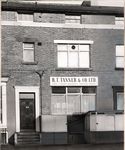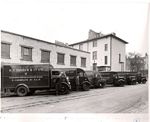RT Tanner & Co Ltd
RT Tanner & Co Ltd
Home
Next page
Previous page
The history of the firm R.T Tanner& Co
World War Two to Move from the City
On the outbreak of war in 1939, many of the staff were already in the Territorial Army, and were called up, but the Company carried on under the restrictions produced by the paper control.


 A heavy blow fell in 1940, when owing to enemy action in the first ‘blitz’ on the City the entire premises in Dorset Rise were destroyed by fire which had spread from neighbouring buildings.
A heavy blow fell in 1940, when owing to enemy action in the first ‘blitz’ on the City the entire premises in Dorset Rise were destroyed by fire which had spread from neighbouring buildings.
The extent of the damage caused by enemy action was preserved in the attached photographs. The fire led to the company's total stock of paper amounting to several hundred tons being lost.
It is this act which also has left many of the company records being lost to us today. Given the loss of so much stock it is surprising that the Company was able to continue to operate especially
given the war restrictions and lack of ready supply of paper.
 The directors were able to act rapidly to locate new premises at Wheatsheaf House, Carmelite Street, London E.C.4.
This allowed the Company to remain in the close proximity to the locality in
which it had always operated.
The directors were able to act rapidly to locate new premises at Wheatsheaf House, Carmelite Street, London E.C.4.
This allowed the Company to remain in the close proximity to the locality in
which it had always operated.
With the end of the war many of the former staff returned from service with the forces, only to find supplies of paper severely restricted by rationing which was based on previous sales. This meant that it was a far from prosperous time in the paper business and the firm faced an uncertain future. However the devastation created by the war was to mark another milestone in the history of the RT Tanner. In 1946 the management structure of the company changed. Arthur Eames, who had been with them for over 50 years, died. George Bird, who had been secretary for 38 years, and Derek Tanner, who originally joined in 1932, returned after service in the armed forces, and both were elected to the Board of Directors.
Since the early days of the war, with the exception of a period in 1951, the paper trade was largely a seller's market. Shortages of supply compounded by the high costs of capital investment, required to increase productive capacity, meant supplies of paper rarely exceeded demand. The editor of the trade circular stated that it was not until 1957 that representatives had to begin to seek orders and work for them.
In the 1950s the Company expanded quickly in the bouyant market. The Hutton Street factory was operating at full capacity so in 1951 a single storey factory in Ashford, Middlesex was acquired, with some of the latest types of envelope and pocket machines
being installed three years later. During the post war period management witnessed a remarkable change in demand for paper, finding samples prepared in 1954 showing scarcely any qualities not undergoing a change in colour, quality and finish.
 In 1957 the expansion of the business saw a new branch being opened in Leeds with an office and warehouse. This was sited next to the South Leeds Haulage Company, who are reported to have had a large fleet of
vehicles, which served the whole of the North of England. Additional investment in the Ashford premises further increased floor space by 40% to meet rising demand.
In 1957 the expansion of the business saw a new branch being opened in Leeds with an office and warehouse. This was sited next to the South Leeds Haulage Company, who are reported to have had a large fleet of
vehicles, which served the whole of the North of England. Additional investment in the Ashford premises further increased floor space by 40% to meet rising demand.
The operations carried out in the factory at Hutton Street was the guillotine of paper board and rotary cutting, postal wrappers, envelope printing, envelope making, hand folding, washering and fitting of metal fasteners,
punching and drilling, perforating, slot and pinhole, bendscoring, round cornering, wire stitching, folding, punching out discs, ovals or shapes from hundreds of stock cutters.
Management reported the substantial investment allowed for a significant improvement in working conditions. Back breaking work of moving and lifting material was done by hydraulic hoists rather by hand. Night storage heaters, air conditioning and
fluorescent lighting ensured a more pleasant environment which was conducive to maintaining high output with minimum human effort, measured by the standards of the day.

 In 1956 the trade circular proudly recorded the acquisition of a new fleet of vans
In 1956 the trade circular proudly recorded the acquisition of a new fleet of vans
"We, for our part, are doing our best by providing smart vehicles and uniforms, and trust that the drivers themselves will keep up the standard of civility and
courtesy with which our delivery service has become associated."
In 1958, just prior to the date on which Arthur Tanner celebrated 60 years with R. T. Tanner & Co Limited, a member of the fourth generation, his grandson Anthony Richard Tanner, eldest son of A. Derek Tanner, having completed his education at Marlborough College in Wiltshire, started work in the factory.
By 1959 the Company had expanded rapidly, and with costs escalating faster than profits, it became evident that the existing premises were inadequate in size and general layout for a modern manufacturing unit, and it was decided that provided a sales office remained in central London a move out of town would be beneficial. There were also major problems within the industry due to poor relations between employers and unions.
For nearly a century the paper trade had been centred around Upper Thames Street, however, when much of the area was destroyed during the war many of those bombed out moved a short distance to the Fleet Street area. After the war the City appeared not to want any manufacturing units within its limits and concentrated solely on building office blocks, congestion in Carmelite Street became appalling, subsequently making it difficult to load the Company’s own vans, and get mill delivery lorries in to unload. Also it was not possible to use any form of mechanical handling, and the authorities would not permit a travelling crane. All bundles were, therefore, loaded and unloaded by hand across a crowded pavement, which was both tedious and expensive.
Another deciding factor was that before the war much counter work was done, samples fetched, patterns matched, and many bicycle boys and vans collected supplies, however, with the improvement in telecommunications few customers came to collect orders. A further problem was finding labour, rail fares were rising and with more of the labour force living on the outskirts of the metropolis, working nearer home became more popular, and for the employee, more cost effective.
For some years the authorities had offered incentives to companies to move out of the City of London to various new towns and depressed areas. For the firm the opportunity would have appeared to have presented itself when the landlord of Hutton Street offered the directors £27,500 to buy the surrender of the lease. Many of the places suggested were not very accessible and for a firm concerned in supplying customers all over the country with stock items, lines of communication and delivery had to be good. After considering several sites it was decided to purchase in Crayford, just 13 miles outside London, a modern single-storey building large enough to house our factory and warehouses under one roof, with a separate office block. Planning permission was also obtained for building an extension when it became necessary. In total the facility was over 50,000 square feet and the handling of products was mechanised as far as possible.
Top